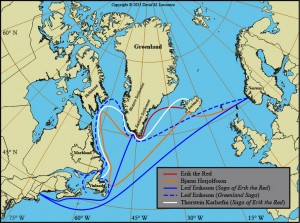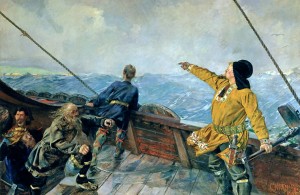Vinland History of the Flat Island Book
MECHANICSVILLE, Va.—The Flat Island Book is a medieval manuscript containing a number of Icelandic tales, including the “Saga of Erik the Red” as well as the “Greenland Saga,” from which this “Vinland History” has been taken.
The stories contained in Erik’s saga and the “Vinland History” overlap to a large extent. I assigned Erik’s saga to the tenth century because a bit more of its length is devoted to events that occurred prior to the turn of the century, while I assigned the “Vinland History” to the eleventh century because, in turn, a bit more of its length is devoted to events that occurred afterward.
My assignment has a significant streak of arbitrary built into it.
Despite the overlap in terms of subject and chronology, there are differences. There is a lot less genealogical and magical content in the “Vinland History.” I found the narrative in the “Vinland History” to be a lot straighter, i.e., much more easily followed and digested.
Likewise, I found the “Vinland History” offered a more clear description of the geography of the places the Norse visited beyond Greenland in the provinces they called Helluland (probably Baffin Island), Markland (probably Labrador), and Vinland (Newfoundland, but possibly including portions of the Lower Saint Lawrence Estuary).
As with Erik’s saga, the “Vinland History” narrative begins with Erik the Red’s history, beginning with his father’s banishment from Norway, Erik’s banishment from Iceland and his subsequent settlement of Greenland.
The next segment begins with his son Leif’s early years, including his conversion to Christianity.

Map of the routes taken by several Norse explorers (intentional or otherwise) to North America in the tenth and eleventh centuries. Redrawn from other sources. Projection is Lambert Conformal Conic with standard parallels of 50 and 70 degrees North latitude. Nominal scale is 1:32,500,000.
The “Vinland History” tells more of Biarni’s story. Biarni is important as the one who, blown off course from a voyage to Greenland, sights the land beyond. Biarni eventually makes it to Greenland and tells Greenlanders what he saw — which in turn inspires Leif, now living in Greenland with his father to set off with the intention of establishing a colony in the land Biarni had found.
Leif establishes his colony, Vinland. He is son followed by his brother, Thorvald, who is killed in a fight with skraelings there. Leif’s other brother, Thorstein Eriksson, plans to go to Vinland to retrieve Thorvald’s body, but before he can go, he and his wife, Gudrid get sick and Thorstein dies. Gudrid eventually remarries. Her new husband is Thorfinn Karlsefni.
One new story in the “Vinland History” is that of Freydis, the sister of Leif, Thorvald, and Thorstein Eriksson, who is of a rather malevolent mind and who engineers the slaughters of members of her and her husband’s colony in Vinland. While a broken-hearted Leif cannot bring his sister to justice once he learns of what she did, he predicts that her descendants will not fare well.
Gudrid establishes another short-lived colony in Vinland with Thorfinn Karlsefni, but their lasting legacy is Snorri — the first modern European child to be born in this so-called New World. While Gudrid and Thorfinn abandon Vinland after about three years, Snorri leave behind a long line of bishops and other prominent folks in Iceland.
The main take-home lesson of the “Vinland History” for me, especially when compared with Erik’s Saga, is the importance of a coherent narrative. Since I had an easier time making sense of the “Vinland History,” I got much more out of the story.
REFERENCE
“The Vinland History of the Flat Island Book.” 1906. Translated by Arthur Middleton Reeves. In The Northmen, Columbus and Cabot, 985-1503: The Voyages of the Northmen. Edited by Julius E. Olson and Edward Gaylord Bourne. Original Narratives of Early American History, 45-66. New York: Charles Scribner’s Sons.

